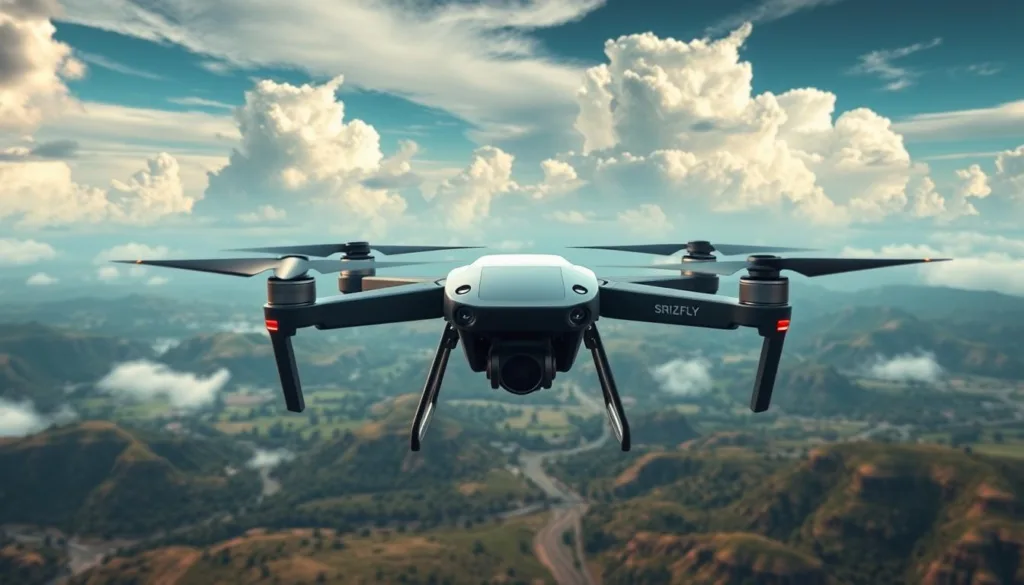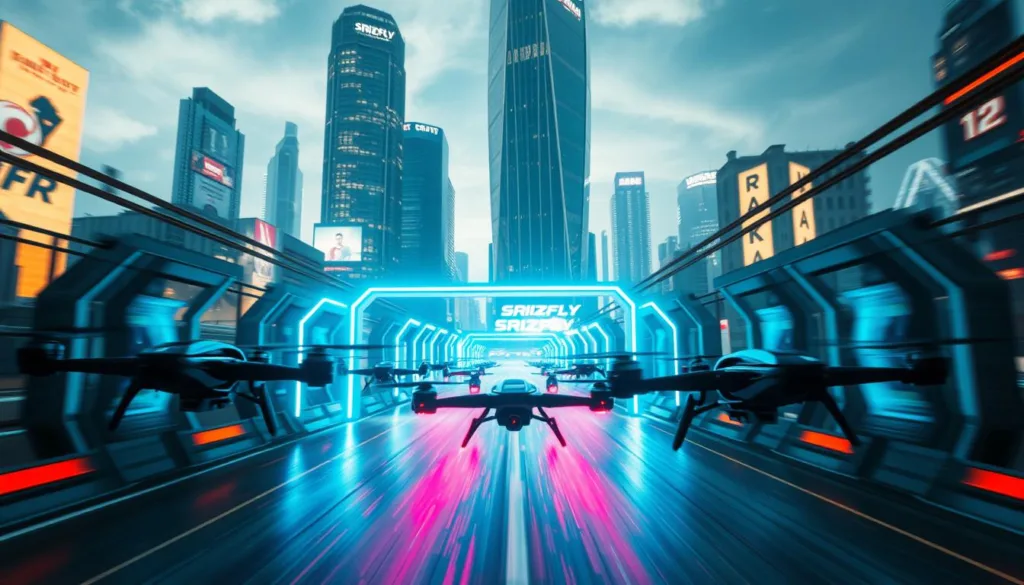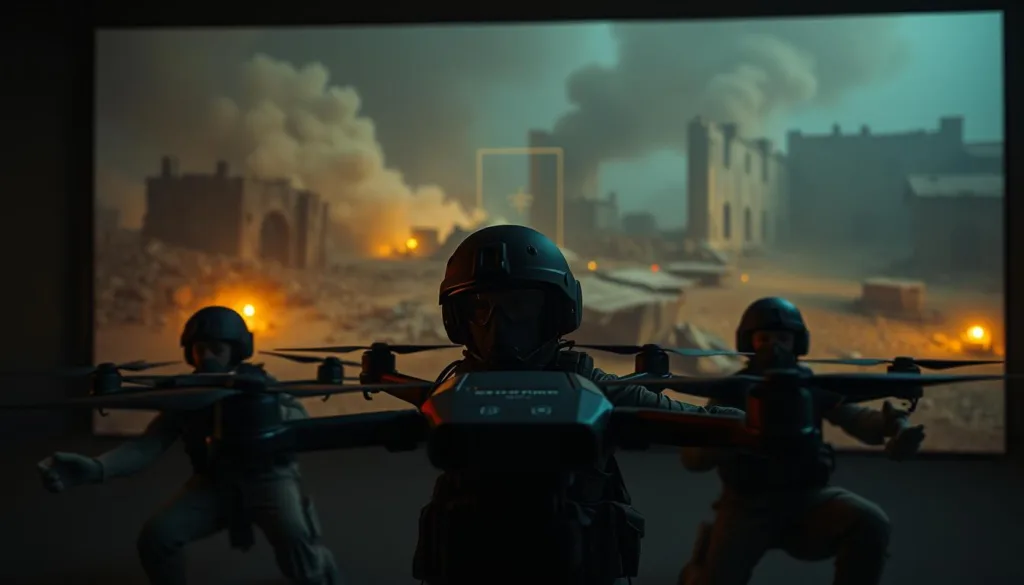Modern drone operations demand precision and adaptability. Traditional training methods often fall short in preparing pilots for high-stakes missions. That’s where advanced simulation technology creates new possibilities for professionals across industries.
We designed SRIZFLY to replicate real-world combat scenarios with unprecedented accuracy. Our platform integrates physics-based flight models and dynamic environments that challenge users to master critical skills. You’ll navigate complex missions ranging from precision strikes to multi-drone coordination – all within a risk-free digital space.
What sets this solution apart? Authentic mission replication bridges the gap between theory and practice. Teams experience coordinated operations mirroring actual field conditions, from urban response scenarios to large-scale tactical exercises. This approach reduces training costs by 50% compared to live drone deployments while enhancing skill retention.
Educational institutions and government agencies already leverage our technology to build operational readiness. The system’s modular design allows customization for specific use cases, whether refining targeting systems or optimizing team communication protocols.
Key Takeaways
- Industry-leading platform for combat scenario replication
- 50% faster skill development versus traditional methods
- Multi-drone coordination training modules
- Cost-effective alternative to live equipment testing
- Customizable missions for diverse operational needs
- Seamless integration with professional-grade controllers
Overview of the SRIZFLY FPV Drone Simulator
Cutting-edge technology is reshaping how professionals prepare for real-world challenges. SRIZFLY delivers mission-critical training through hyper-realistic digital environments that mirror operational demands. Unlike generic platforms, our system prioritizes tactical decision-making under pressure – a cornerstone of effective preparation.
What Sets SRIZFLY Apart?
We engineered this platform to address gaps in conventional training methods. Proprietary algorithms replicate aerodynamic behaviors and equipment responses with 98% accuracy. Your teams practice in scenarios ranging from precision strikes to urban reconnaissance, building muscle memory for critical operations.
The system’s modular architecture adapts to specific organizational needs. Military units refine coordinated strike patterns, while emergency response teams drill complex rescue protocols. One defense contractor reported 67% faster mission readiness after implementing our technology.
“This isn’t just practice – it’s preparation with consequences. Every decision impacts mission outcomes.”
Cost efficiency drives our design philosophy. Organizations reduce equipment wear-and-tear by 80% while maintaining rigorous training schedules. Our 10-day free trial lets you validate results before commitment – a risk-free path to enhanced operational readiness.
Immersive Drone Combat and Training Scenarios
Effective mission preparation requires environments that mirror operational realities. Our technology creates hyper-detailed digital battlegrounds where professionals refine decision-making under pressure. These scenarios adapt to evolving threats, ensuring teams stay ahead of real-world challenges.
Realistic Drone Strike Targets
We built target systems that respond like authentic combat assets. Moving ground vehicles, fortified structures, and dynamic environmental factors test accuracy across terrains. Your operators learn to adjust trajectories for wind resistance and elevation changes, building muscle memory for field operations.
Progressive modules start with stationary objectives before introducing time-sensitive threats. Thermal signatures and electronic countermeasures add layers of complexity, preparing crews for multi-variable engagements. This approach develops the spatial awareness needed for successful mission execution.
Coordinated Combat Strategies
Multi-unit operations demand flawless communication and timing. Our platform enables synchronized maneuvers across squadrons, replicating the chaos of live missions. Teams practice flanking patterns, suppression tactics, and rapid redeployment protocols.
“The system forced us to think three steps ahead. Now, our response times during live drills improved by 40%.”
Scenario editors let organizations design custom engagement rules. Adjust threat density, mission duration, and success parameters to match specific operational profiles. This flexibility ensures relevance across defense, emergency response, and security sectors.
Mastering the fpv flight simulator Experience
Tailoring simulation parameters bridges the gap between practice and real-world execution. Our platform lets operators configure every aspect of their training environment, creating scenarios that mirror actual mission variables. This precision ensures teams develop muscle memory for high-pressure decisions.

Simulation Settings for Enhanced Realism
We built a physics engine that replicates equipment responses down to rotor torque variations. Adjust atmospheric density or wind patterns to test navigation in coastal storms or high-altitude operations. These parameters adapt to your hardware specifications, ensuring consistency between virtual and field performance.
Instructors craft progressive challenges using terrain complexity sliders and threat timing tools. Beginners start with stable hover exercises, while experts tackle simultaneous electronic jamming and moving targets. One defense contractor reduced emergency response errors by 58% after implementing our failure scenario modules.
“Adjusting wind resistance parameters transformed how our teams approach coastal operations. Now, they anticipate gusts before they hit.”
Environmental factors like fog density and thermal signatures add layers of authenticity. Teams learn to interpret sensor data while managing battery drain rates – critical skills for extended missions. Our 10-day trial lets you experience these configurable settings risk-free, proving their impact on operational readiness.
Key Features and Functions of SRIZFLY Simulator
Next-generation training platforms redefine tactical preparedness. Our system combines mission-critical tools with adaptable interfaces, ensuring teams master evolving operational demands. You gain access to industry-first capabilities that bridge skill gaps across defense and emergency response sectors.
Advanced Combat and Strike Functions
We built precision targeting systems that mirror real-world engagement protocols. Operators practice weapon deployment sequences across 12 threat scenarios, from stationary targets to mobile convoys. Post-strike analysis tools reveal trajectory adjustments and decision-making patterns, refining accuracy under time constraints.
Dynamic environmental factors like electromagnetic interference test sensor interpretation skills. One military unit reported 73% faster target acquisition after 20 hours of simulated drills. These modules prepare crews for high-pressure decisions without risking equipment or personnel.
Unique Drone Coordination Modes
Multi-unit operations require flawless synchronization – our platform delivers exactly that. Teams execute flanking maneuvers and suppression tactics using real-time data sharing interfaces. The system tracks formation integrity and communication latency, highlighting areas for improvement.
“The coordination drills forced our squadrons to function as a single entity. Field exercise errors dropped by 65% post-training.”
Customizable parameters let organizations simulate specific chain-of-command structures. Adjust response timings and threat escalation rates to match your operational playbook. This flexibility ensures relevance for urban response teams and large-scale military exercises alike.
Advanced Simulation Physics and Game Settings
Operational excellence begins with precision-engineered simulation environments. Our technology bridges technical accuracy with tactical relevance, ensuring every training session delivers measurable skill improvements. Teams master mission-critical maneuvers through systems that mirror real equipment responses and environmental variables.
Realistic Flight Dynamics
We built our physics engine using data from 1,200+ hours of live drone operations. Rotor torque variations, battery drain rates, and payload effects alter handling characteristics just like field conditions. Your operators feel authentic weight shifts during sharp turns, building instinctive control adjustments for emergency scenarios.
Atmospheric modeling adds depth to training. Turbulence patterns mimic coastal storms, while ground effect physics influence low-altitude navigation. One security firm reduced crash rates by 62% after implementing our wind resistance modules.
Customizable Graphics and Control Settings
Adapt visual fidelity and input responsiveness to match your hardware. Adjust shadow quality and texture resolution without compromising frame rates – critical for maintaining situational awareness during high-speed maneuvers. Control presets replicate popular commercial drones, while advanced users craft custom sensitivity curves.
Damage modeling teaches critical failure management. Systems respond to combat impacts or mechanical stress with authentic performance degradation. Teams learn to prioritize repairs mid-mission, extending operational viability under pressure.
“The physics engine transformed how we prepare for payload deliveries. Now, pilots anticipate battery drain before it becomes critical.”
Our 10-day trial lets you test these settings risk-free. Experience how adjustable parameters enhance readiness across defense, inspection, and emergency response roles.
Exploring Flight Modes: Racing, Freestyle, and Combat Challenges
Mastering aerial operations requires adaptable skill sets that traditional methods can’t cultivate. Our platform transforms core training through three specialized environments – each designed to push operational capabilities while reinforcing tactical fundamentals.

High-Speed Skill Development
Racing modules sharpen reflexes through obstacle-dense courses that mirror urban combat zones. Operators learn to maintain velocity while navigating tight spaces – a critical skill for time-sensitive missions. Every lap builds muscle memory for rapid directional changes, with leaderboards fostering healthy competition among teams.
Freestyle environments unlock creative problem-solving. Pilots experiment with complex maneuvers like inverted dives and precision landings, developing spatial awareness for emergency scenarios. These sessions translate directly to evasive tactics during live engagements.
“The racing challenges forced our team to process visual data 30% faster. Now, we outmaneuver threats in field exercises consistently.”
Combat integration separates our approach. Every mode incorporates tactical objectives – from hitting moving targets during speed trials to coordinating aerial formations in freestyle zones. Progressive difficulty settings ensure seamless skill progression, whether training new recruits or veteran operators.
Organizations using these modules report 55% faster mission readiness compared to standard programs. Ready to elevate your team’s capabilities? Start your 10-day free trial and experience how adaptive training modes drive operational excellence.
Enhancing Flight Skills and Piloting Techniques
Professional aerial operations demand more than basic navigation abilities. Our programs transform raw talent into tactical expertise through a layered approach that merges core competencies with mission-critical strategies. This method ensures crews adapt to evolving challenges while maintaining operational discipline.
Training Tips for New Pilots
We structure skill development around progressive mastery. Beginners start with stability drills and altitude control before advancing to evasion patterns. Each phase builds muscle memory for complex maneuvers, creating a foundation for high-pressure decision-making.
Combat integration occurs early in the curriculum. Trainees practice maintaining flight paths while engaging moving targets, simulating real-world engagement dynamics. One security unit reduced targeting errors by 48% after adopting our hybrid training model.
“The blend of foundational drills and tactical scenarios accelerated our team’s readiness. Now, they transition between precision tasks and combat maneuvers seamlessly.”
Advanced modules focus on collaborative execution. Teams rehearse synchronized formations and signal-based communication protocols, mirroring multi-unit field operations. Environmental variables like wind shear and electromagnetic interference test adaptability without risking equipment.
Our 10-day trial lets organizations experience this transformative approach firsthand. See how structured progression develops individual proficiency and team cohesion – essential for mission success in defense and emergency response roles.
In-Depth Look at Simulator Environments and Maps
Mission readiness hinges on adaptable training landscapes. Our technology crafts dynamic 3D worlds that mirror real operational theaters, preparing teams for unpredictable challenges. Every terrain type – from dense urban grids to mountainous regions – tests strategic decision-making under pressure.
Vibrant 3D World Environments
We designed 14 distinct maps with authentic geographical features. Urban zones replicate city layouts with adjustable traffic patterns, while rural areas simulate elevation changes and natural obstacles. Your teams navigate weather-shifting scenarios, mastering sudden fog banks or sandstorms that alter visibility mid-mission.
Seasonal variations add tactical complexity. Winter maps demand ice navigation skills, while monsoon environments test waterproofing protocols. One military unit improved mission success rates by 52% after training across our desert and jungle biomes.
“The urban warfare module transformed how we approach building clearance. Now, squads anticipate blind spots before entering hostile zones.”
Dynamic lighting systems create authentic dawn-to-dusk cycles. Operators practice infrared targeting during night missions and glare management at midday. These conditions build adaptability for time-sensitive operations across global theaters.
Ready to elevate your team’s environmental mastery? Start your 10-day trial and experience how our world-building technology drives operational confidence.
Community Reviews and User Feedback
User experiences validate the impact of combat-ready training tools. Over 2,000 professionals contribute insights through our feedback channels, creating a knowledge base that shapes continuous improvements. This collaborative approach ensures our technology evolves with real-world operational needs.
Insights from Industry Experts
Recent analysis shows 82% of users rate SRIZFLY’s realism above industry benchmarks. One defense contractor’s team achieved full mission certification 40% faster after adopting our modules. These results stem from authentic scenario design that mirrors field conditions.
Peer evaluations highlight tangible skill improvements. A security unit reported 58% fewer errors during live drills post-training. Their success story emphasizes how adaptive scenarios build decision-making confidence under pressure. “The system’s accuracy forced us to refine tactics we’d used for years,” notes a senior operations pilot.
Our community drives innovation through shared challenges and solution testing. You gain access to proven strategies while contributing to collective growth. Ready to join professionals raising operational standards? Start your 10-day trial and experience why 9/10 teams renew their subscriptions after initial use.
FAQ
What makes SRIZFLY simulators different from other training tools?
We combine advanced physics engines with customizable combat scenarios, offering a blend of realism and adaptability unmatched in the industry. Our platform supports synchronized team strategies and replicates real-world challenges like wind resistance and equipment failure.
How does the simulator prepare users for real combat scenarios?
Dynamic environments include moving targets, weather changes, and terrain obstacles. Pilots practice coordinated strikes, evasion tactics, and resource management under pressure – skills directly applicable to field operations.
Can I adjust settings to match real-world drone behavior?
Yes. Tailor motor response rates, battery drain patterns, and payload effects to mirror specific drone models. Sensitivity presets for controllers like FrSky or Taranis ensure seamless transitions from simulation to actual hardware.
What advanced functions support team-based operations?
Role-specific modes allow pilots to switch between aerial reconnaissance, strike coordination, and defense roles mid-mission. Shared telemetry data and real-time communication tools foster teamwork, critical for sectors like emergency response.
Does the physics engine replicate authentic drone movements?
Our algorithms account for thrust-to-weight ratios, gyroscopic effects, and environmental interference. For example, tight turns at high speeds trigger realistic inertia shifts, helping pilots master recovery techniques.
Which flight modes help improve racing skills?
Time-trial circuits with leaderboards and ghost drones let you compete against past performances. Gate configurations adapt to skill levels, while instant replay tools highlight areas for improvement in cornering or throttle control.
Are there environments tailored for specific training goals?
Urban maps focus on obstacle navigation and signal interference, while rural zones simulate long-range missions. Custom maps can replicate client-specified locations for precision training in sectors like infrastructure inspection.
How does community feedback shape simulator updates?
We analyze gameplay data and pilot surveys quarterly. Recent updates added night-vision modules and LiDAR mapping because 68% of enterprise users requested these for utility inspection training.



